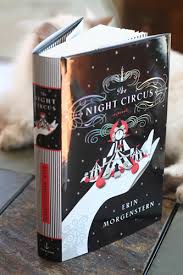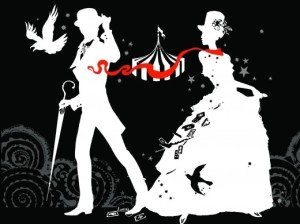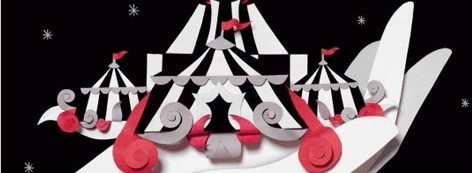Review: ‘The Night Circus’ by Erin Morgenstern
[dropcap]S[/dropcap]ince its publication in 2011, Erin Morgenstern’s debut novel The Night Circus has attracted a host of positive reviews from critics and readers alike. Everyone, from Audrey Niffenegger (of The Time Traveller’s Wife fame) to The Times, Guardian and Heat, has been falling in love with this book and this adoration has been well-documented in paper and online. My interest was piqued by the promise of historical fantasy and the decorative black and white front cover. (There are some bibliophiles strong enough not to be swayed by gorgeous cover art. I, unfortunately, am not one of them.)
In the book world, hype often comes before a fall, but I was pleasantly surprised by what I found. The Night Circus not only lives up to the magical, spectacular reputation it has garnered, but actually (for the most part) exceeds it.
“The circus arrives without warning.
No announcements precede it, no paper notices on downtown posts and billboards, no mentions or advertisements in local newspapers. It is simply there, when yesterday it was not.”
Trying to put what The Night Circus is about into words is a difficult – almost impossible – task. The novel is about atmosphere, fantasy and imagination, and large parts of the book are devoted to individual vignettes surrounding the creation and workings of the titular circus. This is not a book with a traditional, straight-forward plot made from a series of cause-and-effect events. But broadly, The Night Circus is about Celia, the daughter of a stage illusionist called Prospero the Enchanter who also happens to be a real magician. When her mother commits suicide, Celia is sent to live with her cold and somewhat cruel father. Prospero pits Celia against the adopted son of one of his rivals in a contest of magical skill using the newly-created Cirque des Rêves as the venue. What follows is an enchanting and multi-layered story which details not just the growing love between Celia and her rival Marco, but also the circus itself.
 Le Cirque des Rêves is far more than a backdrop to the story. In short sequences interspersed with the main action of the story, Morgenstern introduces us to the different spectacles found at the circus: from illusionists to tarot readers, labyrinths, snake charmers and acrobats. We are given an overwhelming sensory experience which truly brings you into the world of the Night Circus. The main story reveals an intimate understanding of how the circus was conceived and made to us, from the wonderfully elaborate clock to the black and white costumes designed for the performers, and even the human cost to those whose job it is to create and maintain the circus. All this is done without stripping away any of the wonder or mystery which makes the circus itself so appealing.
Le Cirque des Rêves is far more than a backdrop to the story. In short sequences interspersed with the main action of the story, Morgenstern introduces us to the different spectacles found at the circus: from illusionists to tarot readers, labyrinths, snake charmers and acrobats. We are given an overwhelming sensory experience which truly brings you into the world of the Night Circus. The main story reveals an intimate understanding of how the circus was conceived and made to us, from the wonderfully elaborate clock to the black and white costumes designed for the performers, and even the human cost to those whose job it is to create and maintain the circus. All this is done without stripping away any of the wonder or mystery which makes the circus itself so appealing.
It is not only Morgenstern’s imagination which makes the world she creates so appealing, but her writing style as well. I can’t remember the last contemporary title which was so enjoyable to read for the language alone. When Marco creates an illusion of a boat, she writes:
“The wind increases, sending waves of dark ink crashing into the ship. Pages fall from the sails, swirling around them like leaves.”
As well as being a novelist, Erin Morgenstern is also a visual artist, and has even created a deck of monochrome tarot cards in keeping with the themes of the book. The author’s interest in art and theatre translates to the rich imagery she uses to realise the Night Circus.
With such a dazzling world as the setting, it is almost inevitable that many of the characters fade somewhat into the background. Celia Bowen herself is a likeable heroine who tolerates her father’s cruelty and the toll of circus life with brave pragmatism. But her rival and love interest, Marco, and many members of the supporting cast are not fully fleshed out and this, coupled with the sheer number of them, can make it difficult to keep track of who everyone is and what their relationships are to the other characters.
I found the development of Celia’s attraction to Marco to be a little rushed. She spends a sizeable portion of the book unaware of her rival’s very existence, then what feels like a few pages later, she is declaring her undying love and prepared to sacrifice her life for him. This could arguably be explained by the story’s debt to fairy tales, a genre not much fettered by realistic relationship development. But as the Celia – Marco romance is such a significant element of the book, in my opinion it would have been good to devote more time to developing its earlier stages.
 Whether the somewhat thinly drawn characters will impact on your enjoyment depends very much on the kind of reader you are: some will be able to embrace The Night Circus’ emphasis on atmosphere and spectacle over realistic, detailed characterisation, but readers who need a strong, goal-oriented protagonist may struggle with The Night Circus’ kaleidoscope of characters.
Whether the somewhat thinly drawn characters will impact on your enjoyment depends very much on the kind of reader you are: some will be able to embrace The Night Circus’ emphasis on atmosphere and spectacle over realistic, detailed characterisation, but readers who need a strong, goal-oriented protagonist may struggle with The Night Circus’ kaleidoscope of characters.
The Night Circus is not just a case of reading words printed on paper. Like the greatest books, it is an immersive experience. I have never been happier to leave the real world than when I departed for Morgenstern’s exquisitely imagined Cirque des Rêves. Summit Entertainment has already optioned The Night Circus, meaning that we could very well see a film in a few years’ time. Although Morgenstern’s visual style might appear ideal for celluloid, I can’t help but feel that a lot of the charm might get lost in translation. When the circus’ attractions are all rendered in computer generated effects rather than in your imagination, you lose the play between reality and magic which the book creates.
Despite the influences of theatre, visual art, cinema and circus performance, I think that The Night Circus is a uniquely literary experience. This is escapism at its finest and most beautiful, a dazzling and witty story of illusions and love, with a world I am already looking forward to revisiting.
[divider]

Comments